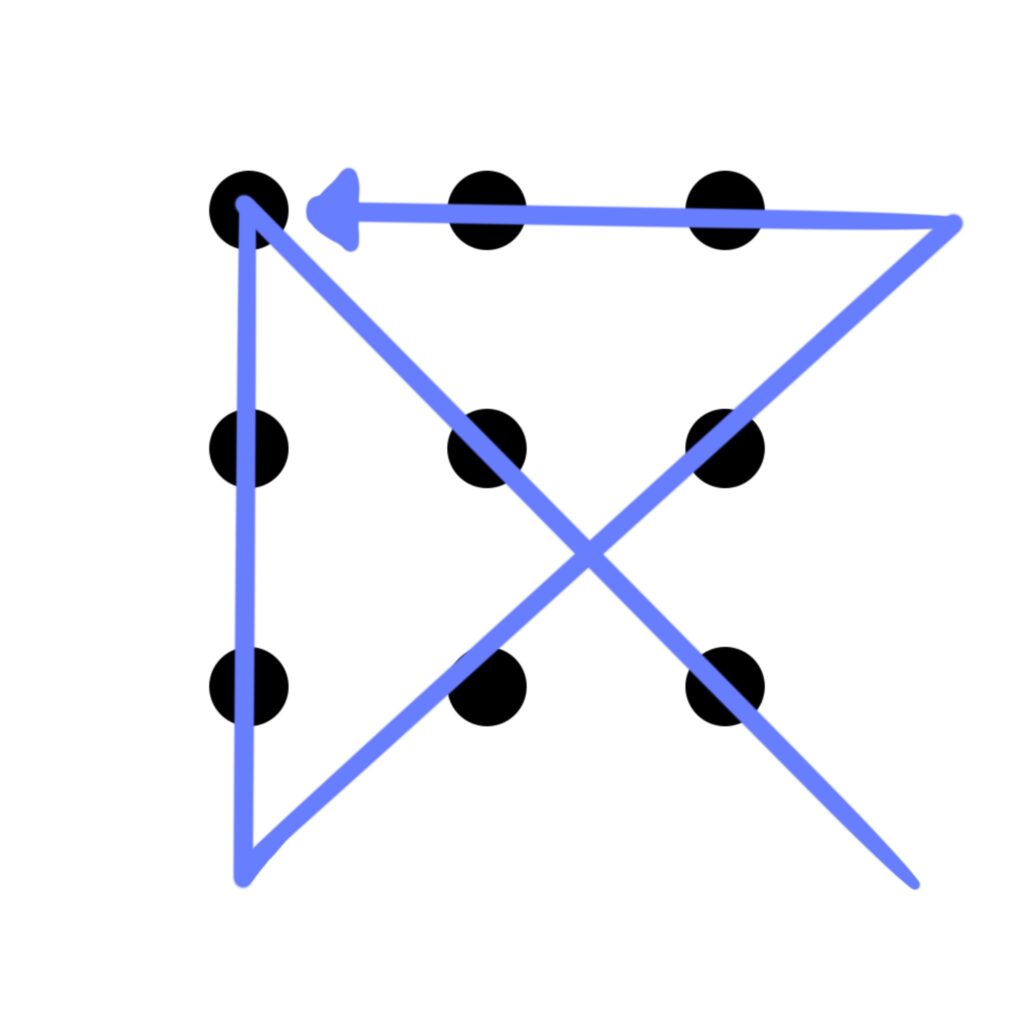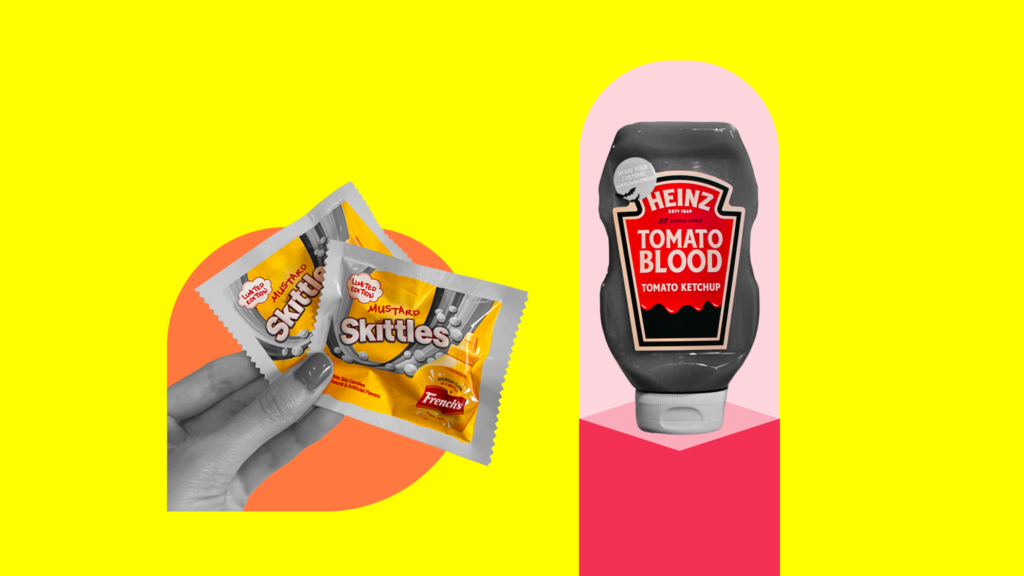Pick your poison…
Mustard Skittles |
Tomato Blood Ketchup |
Two condiments, two limited edition holiday products. One of them works, the other is vomit-inducing (hint: it’s not the blood-themed ketchup).
So what went wrong here? Both ideas are clearly ‘outside the box’ – the highest honor that can be bestowed upon a marketing professional. Why does one work and the other flop? Before we can talk about thinking and boxes and thinking outside of boxes, let’s set a few things straight. First order of business…
What is a box?
It’s easy to picture a small and stuffy cardboard box as a metaphor for restricting your thoughts and creativity. But this isn’t how the famous saying came about. Thinking outside the box refers to a very literal 3×3 grid of dots.
The grid made one of its earliest appearances in “Sam Loyd’s Cyclopedia of 5000 Puzzles, Tricks, and Conundrums” published in 1914.
The grid came with a simple challenge: Without lifting your pen from the paper, connect all the dots with as few lines as possible.
You can give the puzzle a go yourself and then check the solution linked here to see how well you did.
What is thinking?
Now that we’ve got the box covered, let’s move on to thinking. “Thinking outside the box” usually refers to creative thinking. To keep things simple here, let’s say that thinking is the act of creating new thoughts out of old ones.
What is thinking outside the box?
As elegantly illustrated with the 9 dots puzzle – thinking outside the box means breaking free of the arbitrary limits you’ve unconsciously set for yourself. This is also known as lateral thinking – a term popularized by psychologist Edward De Bono.
When thinking outside the box goes wrong
Once upon a time in the distant year of 1950, you could count the number of TV channels on one hand. Brands had an audience of millions to advertise to, and most importantly, they had their attention. Today, things look a little bit different. In the time that it took you to read this far into the article, over 500 hours of video were uploaded to YouTube.
Toss in another half dozen social media and streaming platforms and a high-speed connection to the cumulative knowledge of the human race in its entirety and you’ve got yourself an attention economy. More brands than ever are scrambling for the leftover scraps of attention nestled in between an Instagram post of your coworker’s wedding party and a video of a singing cat.
Here’s the secret sauce though: creativity captures attention. The desperate attempt to stand out in a hopelessly overcrowded market has led to an arms race of creativity that would give the scientists of the Cold War a run for their money. Thinking outside the box has become so valued that we’ve started going…
from this… |
to this. |
Creativity for the sake of creativity, is far removed from goals or purpose. The original 9-dot puzzle encouraged you to think outside the box to find a better, more efficient solution. It wasn’t about tossing the rules in the trash.
Mustard Skittles: A limited edition product created by the French for National Mustard Day. The brand went all out with a beautifully themed car and was reported on by several magazines. Is it out of the box? For sure. But what objective does it fulfill?
It captured attention… but then what? The flavor was universally hated and the partnership between the two brands adds no apparent value to either. The idea is ‘wild and crazy’ for the sake of being wild and crazy. You may as well duct tape a banana to a wall.
Tomato blood ketchup: A limited edition product created by Heinz for Halloween. Ketchup is a fun and playful condiment. A sweet unnaturally red goop that stands out in aisles of cream and brown. You can drizzle it all over your fries and burgers. Kids love ketchup. They like to play with it. So why not lean into the essence of ketchup? With a simple package redesign, an ordinary dinner is transformed into a gory ghoul feast.
Thinking inside the box
Tomato blood ketchup takes a product’s essence and boosts it unconventionally. Instead of following a linear path of thinking “What monster should we put on the packaging? What if we create an ad where vampires love ketchup?” Heinz broke free of regular thinking patterns – thinking outside the box – and temporarily renamed their hero product. Mustard Skittles on the other hand are a shallow cry for attention.
So when it comes to being creative – it sometimes pays to “think inside the box” a little. Get close and comfortable with the core of your brand, its unique selling points, and what makes it tick. Always keep your goals and objectives in mind.
Red Bull used to fill trash cans with empty cans to create the illusion that everyone was drinking it – an out-of-the-box execution of a very inside-the-box proposition (See: 9 out of 10 dentists recommend our toothpaste). Texas’s award-winning littering campaign “Don’t mess with Texas” started with them taking a step back to redefine their audience – the most basic of marketing exercises.
When they discovered that their audience was pickup-truck riding, beer-drinking, and gun-loving teens, thinking outside the box was easy. They pivoted from a tree-hugging angle to a “don’t mess with us” attitude.
Closer to home
Ramadan is ad season in the MENA region. The cost of running ads spikes as consumer attention plummets in an overcrowded space. So how could Thndr stand out?
Getting started with investing, as seamless as Thndr makes it, can take a bit of a learning curve – and having a close friend or family member introduce you can make getting started much easier. That’s why word of mouth can be a particularly effective channel for growth.
An insight we noticed is that during Ramadan, people meet with family and friends almost daily for iftar – the perfect opportunity for spreading through word of mouth. So instead of running ads, we took our referral bonus and doubled it for the entire month of Ramadan. We thought outside the box by first thinking inside the box.
This article was written by Danny Arafa – our in-house creative. From children’s books to food magazines, social media content, and now fintech – Danny loves testing the bounds of creativity with a business-oriented approach.




